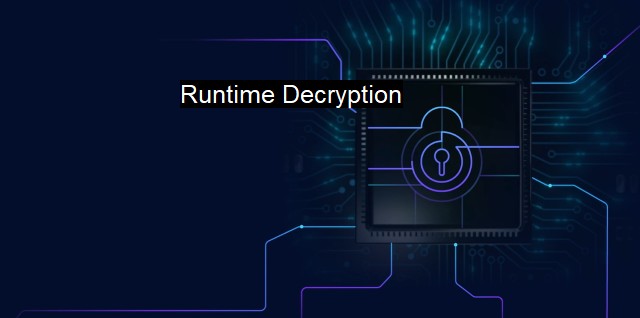What is Runtime Decryption?
Runtime Decryption: Powerful Real-time Cybersecurity Technique Against Malware
Runtime decryption is an essential concept that operates within the realms of cybersecurity and antivirus measures. It is a sophisticated technique used to decrypt a code or data during runtime in order to access information and execute procedural sequences. The function sees widespread application in the domain pertaining primarily to software protection but applies to the broader fields of information security as well. It is not only used to safeguard code against unauthorized usage but also employed extensively by malware to resist detection from antivirus programs.Antivirus tools commonly utilize static code flow analysis to detect malware. with the adoption of runtime decryption by more malign programs, uncovering them has become increasingly challenging. By using encryption algorithms that are capable of obfuscating harmful executable commands within a code network, these malicious applications are masked from antivirus software. This is a daunting challenge for cybersecurity experts as threats continually evolve resulting in the need for updated countermeasures to both identify and neutralize them.
Malware accomplishes its intended task by acting secretly, avoiding detection by both presenting a benign outward appearance and operating behind the safety net of encryption. Runtime decryption ensures that harmful code remains under constant encryption and decryption activities only to surface as clear text in memory locations momentarily just before execution, thereby remaining undetectable. The focus is to surface harmful script and sequences only at the instant it is required to be run. This makes identifying and countering it harder as compared to conventional continuous decryption processes, thereby letting malware stay invisible longer.
Ironically, the further cause for worry is that the codes once identified are tough to reverse-engineer due to the intricacy of encryption algorithms, raising difficulty levels in building protective mechanisms. Not surprisingly in the continually evolving dynamics of cyber threats and their countermeasures, malware developers have become experts in exploiting strong encryption standards to further their interest. In a catch-22 situation for cybersecurity experts, these encryption standards meant to protect data, are being used against the data they are meant to guard.
It’s clear that astoundingly sophisticated encryption and decryption algorithms are central to runtime decryption’s success. Predominantly, Dynamic Encryption or Polymorphic Code Encryption techniques are employed to alter encryption keys and to randomize encryption methods thereby creating a new variant of malware instance after instance to avoid detection patterns known to Antivirus programs.
Despite presenting a substantial challenge, the cybersecurity industry fights back by constantly evolving, coming up with novel prevention and protection strategies. Behavioral analysis techniques are providing one effective countermeasure. By analyzing software’s behavior overtime instead of seeking just suspicious codes, a better prediction of potential risks is granted. This approach doesn’t prevent the initial infiltration but can mitigate its effects by isolating untrusted or suspiciousa programs once they start to execute.
The evolution of heuristic methodologies, too, has proven promising. It involves employing approaches that focus more on the prediction and analysis of behavior patterns associated with malicious scripts rather than only working on recognition of harmful elements.
Runtime decryption has emerged as a wicked shield to protect malicious code while leaving antivirus software grappling with ways to counter it. It's necessity, while evident in protecting useful code and software but has unintendedly created a windows for hackers to stay ahead, underlining the need for cybersecurity experts to keep pace with changes with advanced detection and strategy innovation. The cat-and-mouse pursuit of security measures and the malware they are trying to prevent serves as a stark reminder of the perils and challenges of the digital age. with relentless resilience, technology innovation, and continuous learning, there is hope for a safer cyber world.

Runtime Decryption FAQs
What is runtime decryption in cybersecurity?
Runtime decryption is a technique used by malware to encrypt their malicious code and decrypt it at runtime to evade detection by antivirus software.How does runtime decryption work?
Malware authors use specialized software to encrypt their code, making it unreadable, even to antivirus software. The encrypted code is then stored in the malware's memory. When the malware is executed, the code is decrypted at runtime, allowing the malware to execute its malicious actions undetected.How do antivirus programs detect malware that uses runtime decryption?
Antivirus programs use a range of techniques, such as signature-based detection and heuristic analysis, to detect malware that uses runtime decryption. They may also monitor system memory for suspicious activity and analyze network traffic for signs of malicious behavior.What can users do to protect themselves from malware that uses runtime decryption?
To protect against malware that uses runtime decryption, users should ensure that their antivirus software is up-to-date and configured to scan for unusual behavior. Users should also exercise caution when downloading and installing software, opening email attachments, or clicking on links from untrusted sources.| | A | | | B | | | C | | | D | | | E | | | F | | | G | | | H | | | I | | | J | | | K | | | L | | | M | |
| | N | | | O | | | P | | | Q | | | R | | | S | | | T | | | U | | | V | | | W | | | X | | | Y | | | Z | |
| | 1 | | | 2 | | | 3 | | | 4 | | | 7 | | | 8 | | |||||||